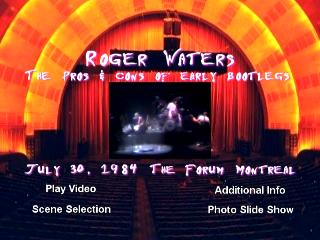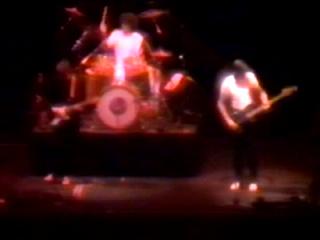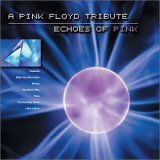


The Camera Eye
Faces blurred by rubber stamps
The Pros & Cons of Early Bootlegging, Montreal, July 31, 1984
Some fans and critics have long labeled Roger Waters 'misogynist', as his lyrical content in The Wall and The Pros and Cons of Hitchhiking suggest that women in his life have caused him great harm. Whether it was his mother or his wife, they were castigated as controlling bricks in his personal wall. While The Wall was very blatantly biased against women, Pros and Cons wasn't nearly so, but it got near- universal condemnation for its cover showing a naked woman hitching on the side of the road.
For his first tour apart from Pink Floyd he assembled Eric Clapton's band, basically calling it "Pink Floyd but with Eric Clapton on guitar". He had recruited Slowhand for his bluesy story of betrayal, isolation, and (eventually) redemption. At the time, Clapton wanted a break from being the leader of his own band, preferring to play in the shadows as part of someone else's; he later found the experience "stifling" and only particpated in the first leg of the Pros & Cons tour during 1984, playing nineteen concerts.
Only three performances from this tour were captured by video bootleggers, and all suffer from the limitations of camcorder technology at the time. In 1984, video cameras were a far cry from the palm-sized Handicams of today. The early video bootleggers had very bulky equipment to sneak into the venue, their cameras required quite a bit of light to produce a decent image, and the zoom lenses were very limited at 4-10x. The huge staging for the tour also presented a challenge to the tapers in that there were three large projection screens that depicted a bedroom where the dream occurs and also showed films which told the story of Reg's dream and his family's adventure into the backwoods of Wyoming. These projections weren't bright enough to come across clearly on the video, and thus a good portion of the visual storytelling is hidden from the viewer.
 The DVD's Main Menu screen. |
Bootleg videos of this tour have surfaced from East Rutherford (New Jersey), Toronto, and Montreal. Unfortunately, the East Rutherford and Toronto shows were recorded from the side of the stage and didn't offer much view of the projections. The only video filmed from the back of the venue was the July 31, 1984 show at The Forum in Montreal. A typical version of this show on VHS would be extremely dark with very little viewable footage of the backdrop films. There isn't much detail seen in the musicians, due to the distant shot and limitations of the camera. With the advent of computer video editing and correction some of these images could be adjusted, making a slight improvement on the VHS versions that had been in circulation. The result was a bootleg DVD called EC Was Here, released by the veteran PF bootlegging outfit Pigs On The Wing Productions. While this was a functional release, it still left much room for improvement.
Recently, an upgraded version of the Montreal concert entitled The Pros & Cons of Early Bootlegging appeared in the trade circles. The source tape for this show was a major upgrade, as the only S-VHS submaster from the original Beta format camera was cloned to Digital8 tape and used for the new DVD release. The improvement is quite noticeable but the video still does suffer from the technology limitations of the time. The original video was shot hand-held, resulting in some shakiness, so the video was run though 'steady shot' software, resulting in a much smoother video to watch. Some brightness and contrast was added to help bring some detail previously unseen out of the video, however there is still a glowing halo effect around the musicians that apparently couldn't be corrected.
 |
The DVD initially opens to a menu screen that has a background picture of the stage before the concert begins but there is a motion video inlay of the band playing which gives the background a clever appearance of the live concert. Background music is a shortened edit of "The Pros and Cons of Hitchhiking". The main menu offers the choice of playing the video, going to a song selection menu, viewing a photo slide show, or reading additional information about the DVD. The song selection screen is only one page long with no motion menu or backing audio track and all 24 songs played at the concert are accessible from this screen. The additional info screen lists the original filmer, as well as the person who performed the digital transfer and the DVD authoring. Credits are given to websites where tour information and pictures were acquired. The Photo Slide Show option shows a four-and-a-half minute collection of photographs taken at the concerts, as well as album covers from various album pressings, single sleeves, and bootleg covers. The photos are shown with a backing audio track playing the full version of "The Pros & Cons of Hitchhiking".
The full concert is a definite upgrade over previous versions, however it is a shame that a better video of this incredible live spectacle isn't available. This video will give you an idea of the stage presentation but the bottom line is that much of the video is still dark. The audio is from the camera but is able to get a decent recording as the camera was away from the crowds of people who could ruin a recording (like most of the 1977 Floyd audio boots). Overall, I would have to say that despite its flaws this should be a must-have bootleg DVD in any good Waters/Floyd collection. It does represent the best Pros & Cons video from either the 1984 or '85 leg of the tour. Even though you miss quite a bit of the show due to darkness, it is still a vital document for collectors of both Roger Waters and Eric Clapton, and I would definitely recommend this version over EC Was Here.
Turn back the covers
The all-female Echoes of Pink tribute project hits the mark
As many of you know, I am a sucker for Floyd covers and tribute albums. I imagine that this is partly because I've heard the original versions so many times that, no matter how much I like them, I still long for something new and fresh. Some tribute projects are really dismal, and attempts to make a Floyd classic 'new and fresh' often result in disappointing (or disturbing) failure.
 Echoes of Pink (2002) |
That said, some tributes really do succeed. One such success is the 2002 http://www.lakeshore-records.com/[Lakeshore Records] release Echoes of Pink: A Tribute to Pink Floyd. Conceived as a showcase for "up and coming acoustic female vocal singer/songwriters", Echoes of Pink features eleven female vocalists performing a variety of well-known Floyd tunes (and a few more adventurous, lesser-known titles) in acoustic settings, backed by guitar, piano, and the occasional vibraphone or cello. Not surprisingly, the results are similar to the music of Sarah McLachlan, Ani DiFranco, or Jewel. Unfortunately, none of the artists featured are actually recognizable (to me, anyway). But as a whole the collection works, often presenting familiar songs in new ways, highlighting the softer, more soothing side of the Floyd's music.
"Wish You Were Here" is an obvious choice for an aspiring acoustic balladeer, and as such it opens the album. It is one of the stronger songs in the collection, and the subtle abridgement of the familiar opening riff, though jarring to the Floyd freak at first listen, becomes less and less bothersome the more you hear it.
"Stay" is ably transformed to guitar-driven number that is vaguely reminiscent of "Green is the Colour". This is one of the real surprises of the album. The simple arrangement--double-tracked acoustic guitars, double-tracked vocals, and light bass--forces you to pay more attention to the lyrics and the pretty, lilting melody. This performance gives me more appreciation for the Floyd original.
Leslie King's rendition "Money", also gives me more appreciation for the Floyd original... though not in a good way. I suppose that including "Money" was inevitable (thankfully, they spared us the horror of an acoustic version of "Another Brick in the Wall, part 2"), but it is really unnecessary, adding nothing new or interesting to the song. Here, the simple arrangement works against the song, as the many layers of guitars and keyboards are sorely missed.
"Cymbaline" is presented as a fluid waltz on the piano, with ethereal backing vocals that give the tune a Victorian feel. The end result comes across as something you might hear played in a ballroom or recital hall (or perhaps some kind of saloon, as suggested by the slightly jangly solo section in the middle). It's a nice interpretation, but quite a striking departure from the darkness of the Floyd's version.
"Us and Them" is much faster than the Floyd ever played it, but the piano and vibraphone are very reminiscent of Rick Wright. Some liberties were taken with the melody here and there, but they work nicely. It's just a little too fast for my tastes, and at this tempo it's far too easy to miss the poignancy of the lyrics.
On the surface, "Hey You" is very faithful to the original, but the closer you listen the more differences you notice. The result is alternately both harder and softer than the Floyd's version. The familiar guitar arpeggios that open the song sound as if they are played on a nylon-string guitar, giving them a distinct earthiness that is missing from the original, and some subtle changes to the pattern are buried underneath the vocals. Jessica Goldman's vocal seems to carry more energy and emotion than David Gilmour's, and the bits of harmony are really well done. Her final verse hints at P.P. Arnold-esque brilliance. Scott Goldman's acoustic guitar solos borrow phrases and ideas from Gilmour, but also take off in directions that are new but seem very familiar, and very right for the song.
I would not have thought of "Time" as a song well-suited for a simple acoustic-guitar-and-bass arrangement, but this performance just goes to show why I'm not a record producer. This track manages to capture all of the beauty and drama of the Floyd version with a minimum of voices and effects. The echoing harmonies in the choruses are haunting, and the wordless vocal that replaces the guitar in the middle makes you--honestly--forget that what is missing is one of Gilmour's masterpiece solos. And the reprise of "Breathe" at the end feels like a natural extension of the song, rather than a switch to something completely different.
Next up is "See Emily Play", which I also would not have thought of as well-suited for this kind of project. In this case, I am proved right. I applaud the producers for their exploration of lesser-known Floyd gems, and I'm sure Syd Barrett appreciates a cut of the royalties. But you can imagine what you get when you take a classic example of psychedelic rock and strip it of the electronics, the powerful organ, the weird harpsichord breaks, and the pounding assault-on-the-senses volume. You get something that sounds like it should work--a woman softly singing lyrics like "Float on a river/Forever and ever" accompanied by piano and sparse tamborine--but the result just sounds forced.
As for "Run Like Hell", I really want to like it. I really do. The opening minute or so--a driving acoustic guitar banging out Gilmour's famous riff--feels like the set-up for something amazing. But although Corinne Sheehan belts out the vocals with what should be suitable fire and energy, they feel somehow anticlimactic. (Perhaps no one can really duplicate the manic rage in Roger Waters' performance.) And while I've never been a big fan of the synth solo on the Floyd version (which always sounded to me like the "Brown Hornet" theme music from the old Fat Albert cartoons), I actually find myself missing it a little.
At least the producers attempted acoustic renditions of unlikely material such as "Run Like Hell". It would have been simpler (and less adventurous) to stick to material that was basically acoustic to begin with. Material like "Brain Damage". The version presented is nice enough, but doesn't really add anything to the superb Floyd original. In fact, this version suffers from the loss of the shuffling meter of the original. The slightly folky feel is replaced by something that feels halting and stilted, and a little lighthearted... in direct contrast to the lyrics.
"Vera Lynn" should have worked, and worked well. There's some lovely cello work toward the beginning. But Waters' simple melody and simple chord progression has been warped almost beyond recognition, and the addition of bells and chimes seems like a blatant attempt to force an air of mystery onto the track. And don't even get me started on the finger cymbal right at the end. Ugh.
Win a copy of Echoes of Pink |
Be sure to visit the 'Contest' page to learn how you can win a copy of the Echoes of Pink tribute album, courtesy of Lakeshore Records and Spare Bricks. |
After a few relative duds toward the end of the disc, we find ourselves at the inevitable closer, "Comfortably Numb". But rather than another 'why bother?' track, this one works. It may be because the songwriting is so strong, but this song is hard to ruin. (That is, unless you have "Scissor" or "Sisters" in your band's name.) It gets off to a slightly shaky start, with too much open space between the piano chords and nothing driving the song forward. When the guitars come in on the second verse, however, the song really gains momentum. The vocal harmonies in the "There is no pain..." sections are perfect, and the acoustic guitar arpeggios really drive the song along. The acoustic slide guitar solo in the middle, spare in notes but elegant and beautiful in its simplicity, captures the spirit (if not the raw power) of Gilmour's playing. The piano solo at the end can't touch Gilmour's soaring guitar heroics, but the style and touch does seem to summon the spirit of Rick Wright, and this sounds very much like the kind of piano solo Wright would have played, especially circa 1968.
Echoes of Pink is likely destined to remain an obscure Floyd tribute project, but it is one that deserves to be heard. The 'good' tracks are very, very good, and the 'bad' tracks aren't really bad... they just fail to do anything new or notable with what is very familiar music.
"To Kill the Child" & "Leaving Beirut"
A review of Roger Waters' latest lyrical offerings
Last fall, Roger Waters released two songs called "To Kill the Child" and "Leaving Beirut". They were initially available for free download streaming on Waters' official website, and are still available as paid downloads on sites such as Napster, or as a Japanese import CD. This is the first new studio material released since his Amused To Death album in 1992, and as usual, the songs deal with his views on war (especially the war in Iraq) and capitalism. The backing vocals are performed by Katie Kissoon, Carol Kenyon, and P.P. Arnold.
"To Kill the Child" begins with soft, beautiful guitar strumming by Andy Fairweather-Low. Then the song changed tone to a serious mood as Roger Waters sings about a child laying in bed in a starlit night while a Donald Duck light glowed, keeping the child 'safe'. He lists material goods and brands that capitalists take for granted before asking, "Could this be the reason/That we would choose to kill the child?"
 The songs "To Kill the Child" and "Leaving Beirut" represent Waters' first new studio releases in more than a decade. |
In the second verse Roger sings about the possibility of war for religious purposes. He lists things such as Allah, Jehovah, Buddha, Christ, the Bible, the Koran, Shinto, and Islam, then boils these down to "Fear of the dark, or shame, or disgrace" before asking the chorus' haunting question. In the third verse, Roger mocks the problem in song by berating, deriding, belittling, chiding, and beating with sticks. There is another religious dig in lines like "you can watch my triumphant procession to Rome / Best seat in the house / Up there on the cross" before ending the verse with his anti-capitalist view: "Is it anger or envy, profit or loss / That we would choose to kill the child?"
There is a beautiful instrumental section with Andy Fairweather-Low providing a soft guitar solo and the backup ladies' repeated "ooh"s. Then the tone of the song becomes far more serious as Roger Waters (becoming louder and angrier) sings "Take this child and hold him closely / Keep him safe from the holy reign of terror". The ladies echo "Take this child, hold him closely", and Roger urges the listeners to take the child to the moral high ground so that he could look down on the bigots out in the yard.
"To Kill the Child" might be viewed as reflecting a mother's feelings, not just Waters' thoughts. The mother remembers her special little boy sleeping in his bedroom, where she thought she would end up keeping him safe. But she couldn't keep him safe, as he grew up and later died in the war in Iraq. She wonders what it is that her child is dying for: to protect the interests of Nissan,
Nike, gasoline, and our 'standard of living'. She also ponders whether the war is being fought for religious purposes. In the third verse she becomes angry and upset, threatening to show the weakness of the American government and crying out for closure. The final verse is the mother warning the other mothers around the world to cherish their children by holding them closely and keeping him from the holy reign of terror. She urges the other mothers to take their children to the moral high ground where they could look down on the bigots and bully boys. She hopes that the other mothers can keep their children from dying in the war as her special little boy later did.
"Leaving Beirut" is a 12-minute long reminiscence of a hitchhiking experience Waters had in 1961. It starts out very slow and peaceful with sounds of a car going by and some 'ooh's and 'aah's from the ladies. Waters begins to tells the story of his hitchhiking north from Beirut, Lebanon. He was picked up (for free, having no money) by an ancient Mercedes 'dolmus' taxi, and takes a moment to describe the other two passengers.
The second verse is actually sung, as Waters asks if those people he rode with deserved to be bombed. He asks if they meant us any harm and explains that this man would never turn people from his door. The Waters and the ladies join together and to sing a line clearly aimed at President Bush: "Oh George! Oh George! / That Texas education must have fucked you up when you were very small." The third verse is again spoken, as Waters describes a polite conversation (in French) between himself and his newfound travel companions (one of which happens to have only one leg).
The fourth verse is sung, and Waters shifts gears a bit, remembering being 17 and taking a road trip to Paris, where everyone was kind to them. They were, after all, the English folks whose dads helped them win the war when they all knew what they were fighting for. He points out that now, in contrast, an Englishman abroad is viewed by many as a stooge of the United States.
The fifth verse reverts to the spoken story of the trip in Lebanon. Waters and the one-legged man walk a half-mile in the dark, as the man has invited Waters to dinner. Approaching his home, they are greeted by his companion's wife, a squat, moustached, hunchbacked woman. He is touched to see the gentleness of the one-legged man and his hunchback wife.
The sixth verse is--you guessed it--sung. Waters wonders if gentleness is too much for us and whether gentleness should be filed with empathy. He once again starts to list capitalist items before he and the ladies sang together "Don't let the might, the Christian right / Fuck it all up / For you and the rest of the world." Waters and the ladies sound sincere when they sing that line.
In the seventh verse Waters describes the hospitality of his host and hostess. The woman later went and brought back their child, who was also apparently somewhat deformed. In the eighth verse, Waters mockingly called Tony Blair a 'great war leader'. He sings that in 1961 they took this child into their home and he wondered how they were doing in what used to be Lebanon. He wondered if he could find them now, make amends, and asked how the story would end. In the final verse (again spoken), Waters went to bed and laid awake all night. In the morning, they said their goodbyes, and parted ways, the one-legged man heading south to the city via the taxi, and Waters walking north, his guitar slung over his shoulder, and the wind drying the salty tears on cheeks.
Waters lyrical treatment of the hunchback woman in "Leaving Beirut" memorable. He is touched by her overwhelming generosity toward him, a perfect stranger. I would imagine that she probably wondered what had become of Waters after he left them, and wondered if she could make amends with Waters after the war in Iraq. As with the mother on "To Kill the Child", she surely tried to kept her own deformed child safe, that is if he didn't die in the terror bombings or the war itself.
When I first heard that Roger Waters had released two all-new songs on the Internet last fall, I was excited. I listened to the download streams and liked the songs. I wanted a good, CD-quality sound, so I ordered the CD single on Amazon's website. I think $20.99 is truly worth it. There were a lot of musical similarities between these songs and his earlier work, and some familiar lyrical lists, as found extensively in Amused to Death and elsewhere. These new songs are a worthy addition to Waters' repertoire.